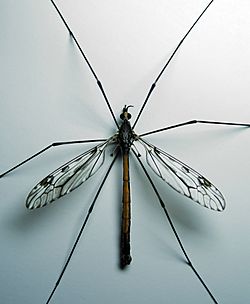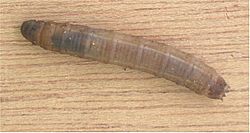Crane fly facts for kids
Quick facts for kids Crane flies |
|
|---|---|
 |
|
| Crane fly adult | |
 |
|
| Larva (leatherjacket) | |
| Scientific classification | |
| Kingdom: | |
| Phylum: | |
| Class: | |
| Order: | |
| Family: |
Tipulidae
|
Crane flies are a type of fly that belong to the family called Tipulidae. They are insects, just like butterflies and beetles. Even though they look a bit like giant mosquitoes, crane flies are harmless! They do not bite people or animals. Sometimes, adult crane flies sip on nectar from flowers.
There are about 15,000 different species and 525 genera of crane flies. This makes the Tipulidae family the largest group of flies! A scientist named Charles P. Alexander discovered most of these species. Adult crane flies usually live for only 10 to 15 days. Their main job during this short life is to mate and lay eggs. Some types of adult crane flies do not eat anything at all.
Contents
What are Crane Fly Larvae Called?
Most of a crane fly's life is spent as a larva. Crane fly larvae are often called leatherjackets. They get this name because of how they move and because their skin can look tough. Leatherjackets like to eat plant roots, especially grass in lawns. Some leatherjackets even live in water.
Why Leatherjackets Can Be a Problem
Because leatherjackets eat plant roots, they can sometimes damage plants. In some places, they are considered a pest for lawns. For example, a type called the European crane fly (Tipula paludosa) can cause a lot of damage to grass.
Crane fly larvae are divided into segments. They have a clear head at the front. The back parts of their body, called the abdominal segments, often have long, fleshy parts that look like tentacles. Scientists have only discovered the larvae of less than 2% of all crane fly species. This means there's still a lot to learn about them!
How to Spot a Crane Fly
Adult crane flies have very long, thin legs and a long, slender body. Their legs are quite delicate and can break off easily if you try to catch them. These fragile legs and thin body might help them escape from birds that try to eat them. Female crane flies usually have bigger bodies than males. The female's body also ends in a pointed part called an ovipositor. It might look a bit like a stinger, but don't worry, crane flies cannot sting!
Wings and Flying
When a crane fly is resting, its wings are often held out from its body. If you look closely, you can see two large parts behind their wings called halteres. These act like balancers and help them fly. Unlike mosquitoes, crane flies are not very good at flying. They might look a bit wobbly when they are in the air.
Size of Crane Flies
Crane flies that live in temperate areas, like some Tipula species, can grow quite large, up to 60 millimeters (about 2.4 inches). In tropical places, some crane flies can be even bigger, growing to more than 100 millimeters (about 4 inches)! The giant crane fly (Holorusia rubiginosa) found in the western United States can reach 38 millimeters (about 1.5 inches).
There are also smaller crane flies, sometimes called bobbing gnats. These are about the size of mosquitoes. You can tell them apart from mosquitoes by a V-shaped groove on the middle part of their body, called the thorax. Also, crane flies do not have ocelli, which are tiny extra eyes found on the top of some insect's heads.
Images for kids
See also
 In Spanish: Tipuloidea para niños
In Spanish: Tipuloidea para niños



